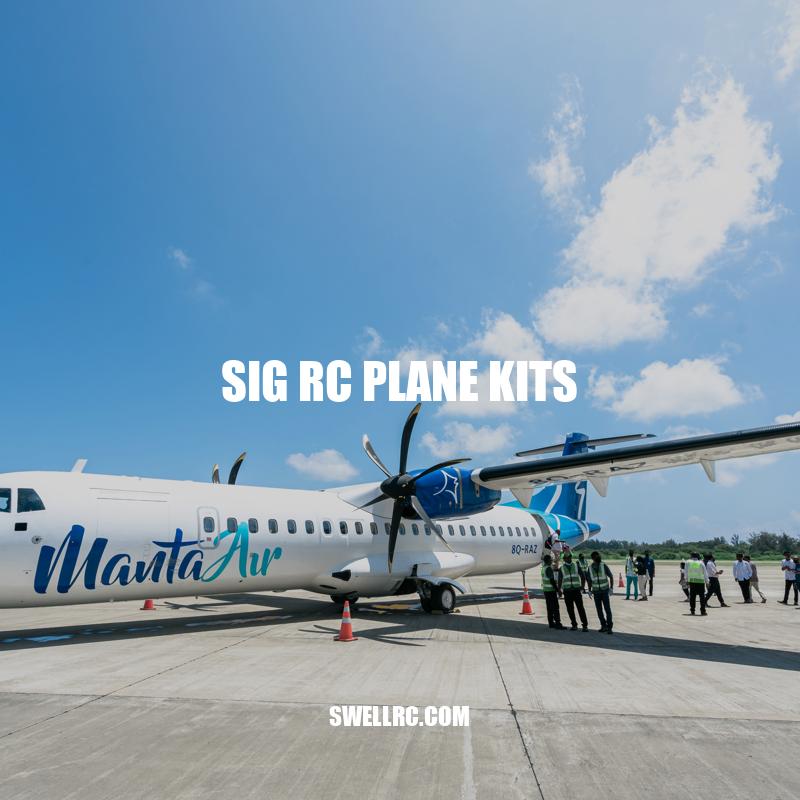Choosing Reliable SIG RC Plane Kits for Your Ultimate Flying Experience
SIG RC plane kits are a popular choice for remote control aircraft enthusiasts looking to build and fly their own model planes. These kits come with all the necessary parts and components to assemble high-quality RC planes, including balsa wood, foam, and ARF (Almost Ready to Fly) options. Choosing the right SIG RC plane kit is essential to ensure a successful build and flying experience. With so many options available, it can be overwhelming for beginners and experienced RC pilots alike. This article aims to provide a detailed overview of SIG RC plane kits, including their types, advantages, assembly process, maintenance tips, and much more. Whether you’re a hobbyist, a competitive flyer or a seasoned pro, this article will equip you with all the information you need to find the best SIG RC plane kit for your needs.
Types of SIG RC plane kits available
SIG offers various types of RC plane kits to cater to different skill levels, price points, and interests:
- ARF (Almost Ready to Fly): As the name implies, ARF kits come pre-assembled with most components glued and screwed in place, requiring only minor assembly (e.g. attaching the wing and tail) and some basic RC gear installation. ARF kits are ideal for beginners and pilots who don’t have experience or time to build from scratch. Some popular ARF models available from SIG include the Kadet LT-25, Four-Star 54, and Kobra.
- Balsa Kits: Balsa kits come with parts cut from balsa or plywood sheets, plans, and instruction manuals. Balsa kits require intermediate to advanced building skills, as you’ll need to shape, sand, and join the parts into a sturdy and aerodynamic airframe. SIG offers several Balsa kits of varying sizes and designs, such as the Rascal 110, Four-Star 20, and Somethin’ Extra.
- Foam Kits: Foam kits are a newer entry in SIG’s RC plane kit lineup. They come with foam parts that are CNC-cut and pre-finished with printed or painted designs, making them both easy to assemble and visually stunning. Some of the popular foam kits from SIG include the Rascal 600, T-Clips, and Fazer. Foam kits require basic building skills and are suitable for intermediate to experienced pilots.
No matter what type of SIG RC plane kit you choose, you can expect high-quality materials, precise engineering, and exceptional flying performance. To learn more about each kit’s features, specifications, and availability, visit the SIG website or attend one of their national or regional events and contests.
What are the different types of RC foam?
The types of RC foam include Expanded Polystyrene (EPS), Expanded Polypropylene (EPP), Expanded Polyolefin (EPO), and Depron. The most popular foam for the RTF market is EPO, commonly known by different trade names given by manufacturers such as ELAPOR by Multiplex and Z-Foam by Horizon Hobby. For more information on these RC foams, check out hobby-specific websites and products.
Choosing SIG RC plane kits over other brands has many advantages, including:
- Excellent quality: SIG uses only the highest-grade materials and manufacturing standards to ensure that their kits are durable, lightweight, and precise.
- Easy to assemble: SIG kits come with detailed instructions, plans, and videos that make building a pleasure rather than a chore. Beginners and experienced builders alike will appreciate the clear, concise, and well-illustrated guidance that SIG provides.
- Availability of replacement parts: SIG maintains an extensive inventory of replacement parts for all their kits, which means that you won’t have to worry about finding hard-to-get components if you need to repair or upgrade your plane.
- Range of designs and sizes: SIG offers a wide variety of designs and sizes to suit every taste and skill level. From classic trainers and sport planes to aerobatic and scale models, SIG has a kit that will fit your needs.
- Affordable: Compared to other brands of RC plane kits, SIG kits are competitively priced and provide excellent value for money.
SIG RC plane kits have been a favorite of modelers for over 60 years. Some interesting facts about SIG include:
| Fact | Description |
|---|---|
| History | SIG was founded in 1951 by Lou and Sig Somers, who started by selling balsa wood in their basement. Today, SIG is one of the largest and most respected names in the hobby industry. |
| Accomplishments | SIG has won numerous awards and contests over the years, including multiple National Championships, AMA Hall of Fame inductions, and several Guinness World Records for building and flying giant-scale RC planes. |
| Community | SIG fosters a strong sense of community among its customers, with a dedicated forum, magazine articles, tutorials, and events that bring modelers together for fun, learning, and competition. |
To experience the benefits of SIG RC plane kits firsthand, visit the SIG website or your nearest hobby store and check out their full range of products.
What is the best RC plane to buy?
When it comes to purchasing an RC plane, there are several great options available. The VOLANTEXRC MiniTrainstar and Sport Cub 500 Parkflyer, the VOLANTEXRC 4-CH P51 Mustang, and the Top Race RC Plane TR-C385 are all popular choices. For more advanced pilots, the E-flite UMX Turbo Timber and Pitts S-1S 850mm BNF Basic offer extra features and capabilities. Ultimately, the best choice depends on the buyer’s experience level and personal preferences. Interested buyers can check out the official websites for each brand or look for reviews online to compare the models and make an informed decision.
SIG RC plane kit assembly process
Assembling a SIG RC plane kit is a rewarding experience that can be broken down into several steps:
- Read the instructions carefully before starting
- Gather all the necessary tools and materials
- Cut out the balsa and plywood pieces carefully
- Use a building board or a flat surface to assemble the fuselage and wings
- Glue the joints together using the recommended glue
- Sand and shape the parts to achieve a smooth finish
- Install the electronics and radio system
- Test the controls and make any necessary adjustments
- Pick a good weather condition to take the aircraft out for its maiden flight
To help builders complete their SIG RC plane kit more efficiently, SIG provides detailed instructions, plans, and videos that address common challenges and offer expert tips. Some helpful resources include:
- The SIG website: Visit the website to browse the available kits, order parts, purchase tools, and read helpful blog posts and articles.
- The SIG building manual: Every kit comes with a comprehensive building manual that covers the basics of building an RC plane, as well as advanced techniques for more experienced builders.
- The SIG YouTube channel: The channel is a great resource for visual learners, as it offers step-by-step tutorials, interviews with experts, and exciting footage of SIG planes in action.
No matter what your experience level is, building a SIG RC plane kit can be a fun and rewarding hobby. With the right tools, materials, and guidance, you can create a high-quality aircraft that will stand the test of time.
How to build your own RC plane?
Building your own RC plane can be a fun and rewarding experience. Here are the steps to follow:
Step 1: Find a purpose for your aircraft. Determine if you want to build an aerobatic plane, a glider, or a trainer.
Step 2: Pick your electronics. Choose a motor, battery, ESC, and servos that are appropriate for your chosen purpose.
Step 3: Estimate the total weight of your aircraft. Use online calculators or formulas to determine the weight of your plane and make sure it is balanced.
Step 4: Find wing cube loading. This information is necessary to ensure that your plane will fly properly.
Step 5: Decide on a wingspan. A longer wingspan means the plane will be more stable in the air.
Step 6: Design your fuselage and tail section. Use CAD software or templates to design the shape of your plane’s body and tail.
Step 7: Decide how to transport your plane. Consider how you will be transporting your plane and design it accordingly.
There are many resources available online that can help guide you through the process of building an RC plane, including tutorials on websites like Flite Test and RC Groups, as well as kits and materials available for purchase on websites like Horizon Hobby and HobbyKing.
Tips for maintaining SIG RC plane kits
To ensure your SIG RC plane kit stays in top condition, here are some tips for proper maintenance:
- Inspect the plane before every flight: Check for any damage, loose parts, or wear and tear
- Clean the plane regularly: Use a soft cloth to wipe off any dirt, dust, or debris, and avoid using abrasive cleaners that could damage the finish
- Store the plane in a dry, cool place: Avoid exposing the plane to extreme temperatures, humidity, or sunlight
- Replace any damaged or worn-out parts: Always use genuine SIG replacement parts for optimal performance and safety
- Follow the manufacturer’s maintenance schedule: Refer to the manual or the SIG website for recommended maintenance tasks and intervals
SIG also offers a variety of tools and products that can help keep your RC plane running smoothly. Some of these include:
| Product | Description |
|---|---|
| Du-Bro Hinge Slotting Tool | A handy tool for cutting hinge slots in balsa wood and other materials |
| SIG Supercoat Butyrate Dope | A high-quality finish that protects the plane from fuel and weather damage |
| SIG Shrinkable Lipo Battery Pack | A lightweight and powerful battery pack that delivers reliable performance |
| SIG Easy Hinges | A simple and effective hinge system that reduces assembly time and improves flight performance |
By following these maintenance tips and using high-quality tools and products, you can enjoy your SIG RC plane kit for years to come. You can find more information and products on maintenance of SIG RC plane kits on the SIG Manufacturing website.
How do you secure a battery on a RC plane?
To secure a battery on an RC plane, it’s common to use hook and loop tape or battery straps. Hook and loop tape can be adhered to both the airplane and the battery, allowing for a secure and adjustable fit. Battery straps can also be used, which cinch around the battery and airplane to hold it in place. For a visual demonstration, check out this helpful video on YouTube: https://www.youtube.com/watch?v=hPKwumcCY7s.
Conclusion
SIG RC plane kits are an excellent choice for both beginners and experienced pilots who want high-quality and reliable planes. With a variety of options to choose from, SIG offers something for every type of flying enthusiast. Whether you prefer balsa, foam, or ARF kits, SIG offers top-notch quality that is sure to impress.
Moreover, maintaining the SIG RC plane kit is easy when you know what to do. Regular inspections, cleanings, and replacements of worn-out parts are necessary to keep your plane in excellent condition. With some simple tips and tools that SIG offers, you can keep your plane running smoothly and safely.
In conclusion, if you’re looking for a high-quality and durable RC plane kit, SIG is a top brand to consider. With its commitment to producing reliable products, SIG has become a trusted name in the RC plane industry. Trusting in SIG can lead to countless hours of flying fun that’s easy to build and maintain.



